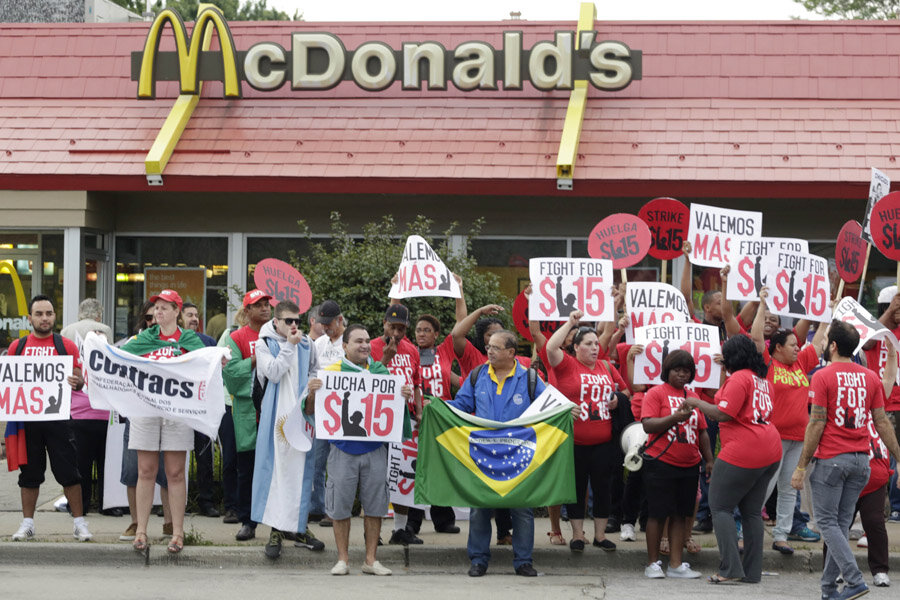Fast food workers in the US strike, face arrests. What progress have they made?
Loading...
As the fight for higher worker wages nears its second anniversary, what progress has the movement made?
Fast food workers kicked off another round of nationwide strikes Thursday, re-iterating their demands for a $15 minimum wage and the right to unionize. Like past protests, today’s will involve walkouts from workers in 150 cities from a wide range of fast food chains, including Wendy’s, Burger King, KFC, and McDonald’s.
According to early reports, a handful of protesters in New York and Detroit were handcuffed Thursday morning for blocking the streets near fast food establishments.
Organizers had indicated earlier this week that Thursday’s activities could take a few pages from the civil rights movement, as workers in several cities were trained in civil disobedience tactics, like sit-ins, in preparation for the nationwide walkout. Additionally, home health care workers, who also face a job full of low wages and irregular hours, are also expected to participate in some cities.
The protests are part of the “Fight for 15 movement,” which is backed financially by unions like the Service Employees International Union. It began in late 2012 targeting both fast food and major retail establishments, like Wal-Mart and Target. Today’s strikes were announced shortly after President Obama gave a shout out to the fast food workers’ efforts in a Labor Day speech in Milwaukee.
“All across the country right now there’s a national movement going on made up of fast-food workers organizing to lift wages so they can provide for their families with pride and dignity…” the President said. “If I were looking for a job that lets me build some security for my family, I’d join a union. If I were busting my butt in the service industry and wanted an honest day’s pay for an honest day’s work, I’d join a union…I’d want a union looking out for me.”
On some level, Thursday’s fast food worker strike differs little from previous strikes that have taken place over the past two years. But there’s a key difference. After a summer filled with minimum wage hikes in certain cities, key legislative rulings, and decisive victories for other protest movements, the cause of low-wage workers in fast food, retail, and other industries is looking imminently more winnable than it did a short while ago.
With the federal minimum wage sitting at $7.25 an hour, the labor movement’s call for a $15 starter wage seemed like a pipe dream at the start. But higher worker wages are being taken very seriously at the legislative level. Earlier this year, President Obama endorsed a plan to raise minimum wage to $10.10. The measure stalled in Congress, but 10 states have meanwhile moved to raise their minimum wages to $10.10 or higher in 2014, including Connecticut, Maryland, Hawaii, Massachusetts and Vermont. Seattle voted in June to raise its city minimum wage to $15 an hour by 2018, and San Francisco is voting on a measure to do the same in November. Several other cities, including Washington, D.C. and San Diego, have voted to raise their minimum wages this year, and many others are considering it.
Companies, too, are taking up the issue. Gap, Inc. announced it would raise its starting wage to $10.10 in February, and furniture chain Ikea introduced a scaled pay system that based pay on the cost of living for employees in various cities. Sixty-nine percent of Americans support raising the minimum wage to $10.10 an hour, according to a recent Bloomberg poll.
On the legal end, the movement scored a major victory last month when the National Labor Relations Board ruled that the McDonald’s corporation could be held liable for labor and wage violations by its franchisees. Under previous rules governing franchisees, McDonald’s could not be held accountable when its franchise owners were accused of illegal practices like forcing employees to work off the clock, refusing to pay for uniforms, and denying overtime pay. Ninety percent of US McDonald’s locations, and most other fast food companies, operate via the franchise model. The decision could have a major impact on the accountability of the industry if upheld, and it potentially give workers more leverage and bargaining power.
The National Restaurant Association denounced the decision and released a statement this week calling the protests an attempt by unions to "boost their dwindling membership."
Still, the industry holds the leverage, and a $15 an hour wage is a long way off in most places. But it’s perhaps not as far off as it once was.








